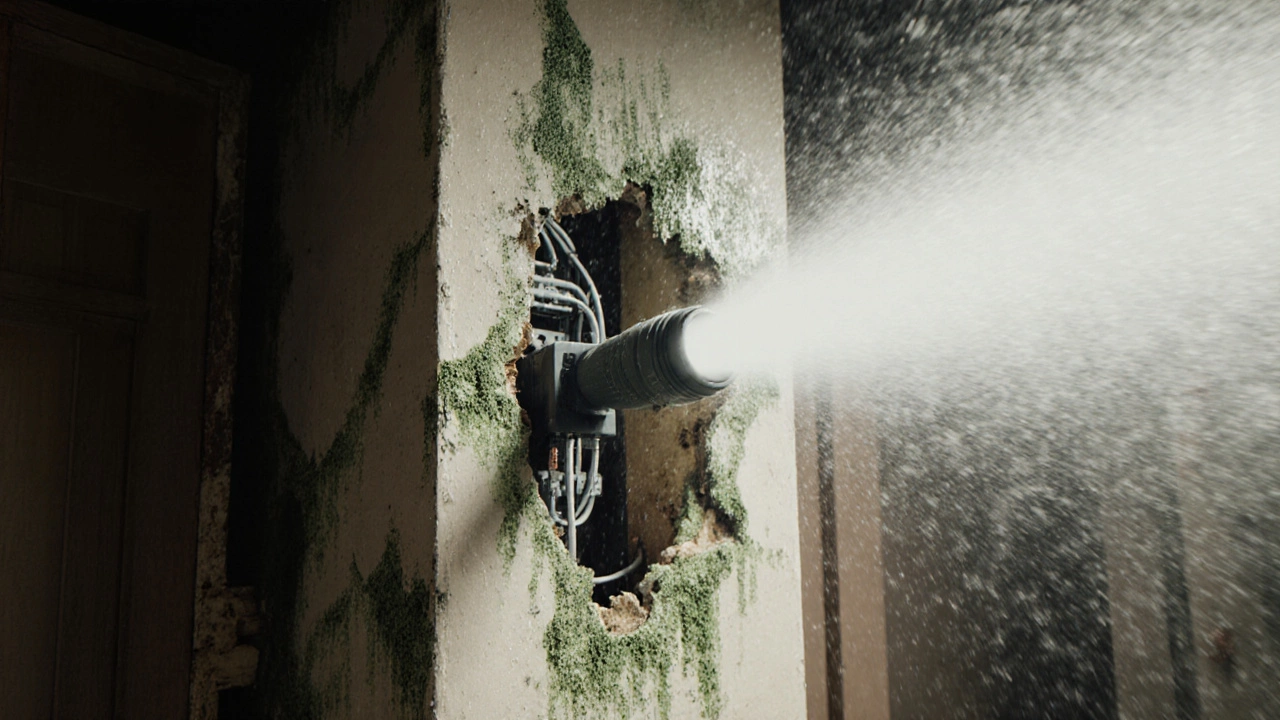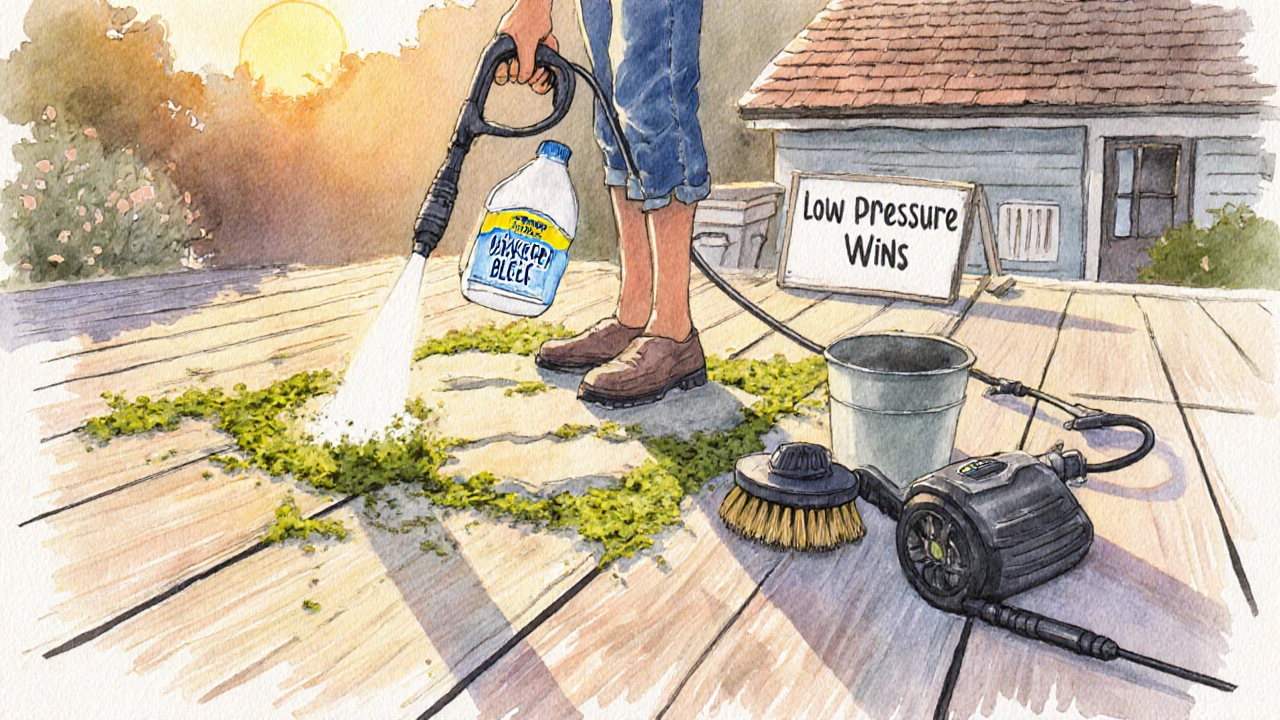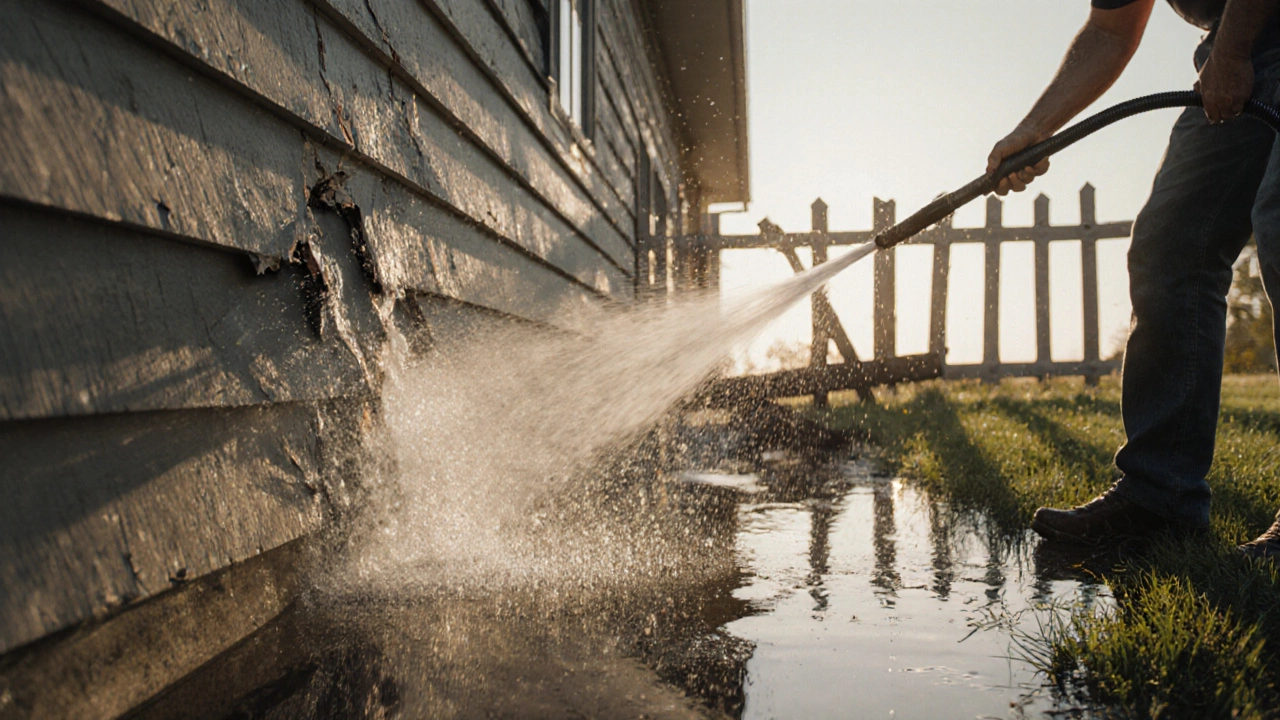Pressure Washer Safety Calculator
Surface Damage Risk Assessment
Determine safe operating parameters for your pressure washer based on surface type and PSI. Avoid costly damage to your home.
Recommended Settings
Critical Warning
High pressure can cause serious damage to your surfaces. The article warns that holding the nozzle too close can crack driveways, splinter fence boards, and rip vinyl siding.
Everyone talks about how powerful pressure washers are. They strip away dirt, grime, and old paint in minutes. But here’s the truth most ads won’t tell you: pressure washer misuse can cost you hundreds-or even thousands-in repairs. I’ve seen driveways cracked, fence boards splintered, and vinyl siding ripped off by people who thought more pressure meant better results. This isn’t about scaring you. It’s about helping you avoid the mistakes I’ve watched too many homeowners make.
It Can Damage Surfaces Instantly
Pressure washers don’t clean-they blast. The water comes out at 1,300 to 4,000 PSI. That’s enough to strip paint off your car in one pass. On softer surfaces like wood, stucco, or vinyl siding, even a 1,500 PSI machine can cause serious damage if you hold the nozzle too close or use the wrong tip.
Think about your deck. That beautiful cedar planks you spent money on? A 2,500 PSI nozzle held just 6 inches away can gouge the wood, leaving deep grooves that trap water and rot faster. Same goes for brick. The mortar between bricks is softer than the brick itself. High pressure can erode it away, leaving your wall structurally weak. One wrong move, and you’re looking at a £1,500+ repair job.
Water Can Get Where It Shouldn’t
Pressure washing isn’t just surface cleaning. It’s a high-powered water cannon. And water finds every crack, gap, and seam. I’ve helped fix homes where people pressure washed their siding, thinking they were protecting it. Instead, they forced water behind the cladding. Inside the walls, moisture built up. Mold grew. Drywall rotted. By the time they noticed the smell, the damage was hidden-and expensive.
Windows are another big risk. Even if you think you’re being careful, water can seep past seals. That leads to damp patches inside, peeling paint, and warped frames. Same with electrical outlets, light fixtures, or air conditioning units. A single accidental spray can short out wiring or ruin a compressor. Always turn off and cover anything that shouldn’t get wet.
It’s Dangerous to Use
Pressure washers aren’t toys. The water stream can cut skin. I’ve seen cases where people lost feeling in their fingers after a direct hit. The nozzle doesn’t even need to be on full power-1,000 PSI can still cause serious injury. And if you’re using a gas-powered model, there’s the risk of fuel spills, hot surfaces, and carbon monoxide if used in enclosed spaces.
Slipping is another hidden danger. Wet surfaces turn into ice rinks. I’ve seen people lose balance on a wet patio, grab a railing, and rip it clean off the wall. Or worse-fall and break something. Always wear non-slip shoes. Never point the nozzle at yourself, others, or pets. Keep bystanders at least 10 feet away.
Noise and Environmental Impact
Gas-powered pressure washers are loud. We’re talking 75 to 95 decibels-about as noisy as a lawnmower. If you live in a residential area, you’ll annoy your neighbors. Some councils in Bristol have quiet hours for power tools, and pressure washers fall under that. You could get a complaint-or even a fine.
Then there’s the runoff. The soap you use, the dirt, algae, oil, and chemicals you’re washing off your driveway? That water flows straight into gutters, then into rivers and drains. In the UK, this can violate environmental regulations. You’re not supposed to wash pollutants into storm drains. Even biodegradable cleaners can harm aquatic life if used in large amounts. Always contain runoff. Use a bucket and scrub brush for small jobs instead.

It’s Not Always the Best Tool
Just because you have a pressure washer doesn’t mean you should use it for everything. Cleaning windows? You’ll leave streaks and risk breaking seals. Washing your car? You’ll strip wax and damage paint. Cleaning a patio with moss? You might blast away the surface layer but leave the roots behind-so it comes back in weeks.
For delicate jobs, a soft wash system with low pressure and specialized cleaners works better. It kills algae and mold without tearing up surfaces. I’ve seen people spend £200 on a pressure washer, then another £300 fixing the damage. A £50 garden sprayer and some oxygen bleach cost less and do the job safely.
Storage and Maintenance Are Often Overlooked
Pressure washers aren’t set-and-forget tools. If you store them wet, the pump will rust. If you leave fuel in a gas model over winter, the carburetor gums up. I’ve seen machines bought new, used twice, then thrown out because they wouldn’t start.
Electric models need a proper outdoor-rated extension cord. Gas models need regular oil changes and spark plug checks. And the nozzles? They wear out. A clogged or worn nozzle changes the spray pattern and increases pressure dangerously. Replacing them costs £5-£15, but most people don’t even know they need to.
False Sense of Power
Here’s the biggest trap: people think pressure washing is a quick fix. You spray, it looks clean, and you’re done. But surface-level cleaning doesn’t solve the real problem. Mold on your shed? Pressure washing removes the black spots-but not the spores underneath. It comes back in a month. Grease on your driveway? You’ve pushed it into the cracks. Rain washes it into the soil.
Real cleaning means treating the cause, not just hiding it. That often means using the right cleaner, letting it sit, scrubbing gently, then rinsing with low pressure. Rushing with high pressure gives you a short-term win and a long-term headache.

When You Should Avoid It Altogether
Some things just shouldn’t be pressure washed:
- Roof shingles-pressure will dislodge granules and shorten lifespan
- Windows with broken seals-water will get inside and ruin insulation
- Outdoor electronics-sensors, lights, security cameras
- Wooden furniture with finishes-paint and varnish will peel
- Asphalt driveways with cracks-water will seep in and freeze, widening cracks
If you’re unsure, test a small, hidden area first. Use the lowest pressure setting. Hold the nozzle at least 18 inches away. Watch how the surface reacts. If it starts to look fuzzy, pitted, or discolored, stop. That’s your sign.
Alternatives That Work Better
You don’t need a pressure washer for every job. Here’s what works better in some cases:
- Moss on roofs or patios: Oxygen bleach spray. Leave it for 15 minutes, then rinse with a hose.
- Grease on driveways: Degreaser + stiff brush. Let it sit, scrub, then rinse gently.
- Windows: Squeegee + vinegar solution. No water spray needed.
- Deck cleaning: Deck cleaner + scrub brush. Low-pressure rinse only.
These methods take longer, but they’re safer, cheaper, and more effective long-term. And they won’t leave you with a £1,200 repair bill.
Final Advice: Know Your Limits
Pressure washers are powerful tools. But power without control is dangerous. If you’re not confident handling one, hire a professional. Most local services in Bristol charge £80-£150 for a full driveway and patio clean. That’s less than the cost of fixing one damaged fence or window.
And if you do use one? Start low. Go slow. Protect everything around you. Read the manual. Wear safety gear. And never assume more pressure equals better results. Sometimes, the quietest tools do the best job.
Can a pressure washer damage my house?
Yes, absolutely. High pressure can strip paint, erode mortar, crack siding, and force water behind walls. Even a 1,500 PSI machine can cause damage if used incorrectly. Always test on a small hidden area first and keep the nozzle at least 12-18 inches away.
Is it safe to pressure wash my car?
It’s risky. Most car paint can’t handle more than 1,200 PSI. Higher pressure can strip wax, chip paint, and damage seals around windows and lights. Use a dedicated car wash system or hand wash instead. If you must use a pressure washer, use the widest nozzle, keep it over 2 feet away, and never use detergent meant for driveways.
Why does my pressure washer keep losing pressure?
The most common reasons are a clogged nozzle, worn pump seals, or air in the system. Check the nozzle first-clean it with a pin. If that doesn’t fix it, check for leaks in the hose or inlet filter. If the pump is old, seals may need replacing. Always run water through the machine before starting to prevent air locks.
Can I use a pressure washer in the rain?
Electric models are dangerous to use in rain-you risk electrocution. Gas models can be used, but wet surfaces become slippery, increasing fall risk. Also, rain dilutes cleaning solutions and makes dirt harder to remove. It’s better to wait for dry weather. If you must work in damp conditions, wear rubber boots and keep electrical parts covered.
Do I need special detergent for pressure washing?
You don’t always need it, but using the wrong detergent can damage surfaces or harm the environment. Never use household bleach or strong acids. They can eat away at metal, concrete, and plants. Use cleaners labeled for pressure washers-they’re pH-balanced and safe for most surfaces. Always check the label for compatibility with your surface type.
How often should I replace my pressure washer nozzle?
Nozzles wear out after 10-20 hours of use. Signs include reduced pressure, uneven spray, or a wider spray pattern than before. Replace them every 6-12 months if you use the machine regularly. Keep spare nozzles on hand-they’re cheap and prevent accidents caused by malfunctioning spray patterns.
Next Steps: What to Do Now
If you’re thinking about buying a pressure washer, ask yourself: Do I really need it? Can I achieve the same result with a brush, bucket, and garden hose? If the answer is yes, save your money and your surfaces.
If you already own one, take five minutes today to check your nozzle, inspect your hoses for cracks, and read the manual again. Make sure you know the right pressure for your surfaces. And if you’ve already caused damage? Don’t panic. Many issues can be repaired-especially if caught early. A little care now saves a lot of cost later.
